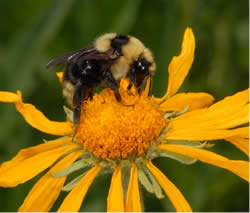Indiscriminate cuckoo bumblebee facts for kids
Quick facts for kids Indiscriminate cuckoo bumblebee |
|
|---|---|
 |
|
| Conservation status | |
| Scientific classification | |
| Genus: |
Bombus
|
| Species: |
insularis
|
| Synonyms | |
|
|
The Bombus insularis is a type of bumblebee known as the indiscriminate cuckoo bumblebee. It belongs to a special group of bumblebees called Psithyrus, or cuckoo bumblebees. This bee is found across northern and western North America. You can find it in Canada, Alaska, the northern United States, and some western states.
What Does It Look Like?
The female indiscriminate cuckoo bumblebee is about 1.6 to 1.9 centimeters long. That's about the length of a paperclip! She is almost a centimeter wide. Her head is black with some yellow hairs. Her body, called the thorax, has long, pale yellow hairs. Her legs are black and hairy. Her belly, or abdomen, is black with yellow on the sides.
The male bee is smaller than the female. His abdomen is about half a centimeter wide. His head has long black hairs with small yellow spots. His abdomen has stripes of yellow and black hairs.
Where Does It Live?
This special bumblebee lives in different kinds of places. You can find it in cold, treeless areas called tundra. It also lives in taiga, which are huge forests with lots of pine trees. It likes western mountain ranges and some areas near the ocean.
A Cuckoo Bumblebee's Life
The indiscriminate cuckoo bumblebee is a bit unusual. Unlike most bumblebees, it doesn't build its own nest. Instead, it's a "cuckoo" bee. This means the female bee finds the nest of another bumblebee species. She then takes over the nest. The worker bees from the original nest then raise the cuckoo bee's young.
Here are some of the bumblebee species that the indiscriminate cuckoo bumblebee uses as hosts:
- The white-shouldered bumblebee (B. appositus)
- The yellow bumblebee (B. fervidus)
- The yellow-fronted bumblebee (B. flavifrons)
- The Nevada bumblebee (B. nevadensis)
- The orange-belted bumblebee (B. ternarius)
Is It Doing Okay?
The indiscriminate cuckoo bumblebee is still common in many places. However, its numbers have gone down in some areas. It has even disappeared from a few parts of where it used to live. Some of the bumblebee species it relies on have had even bigger declines.
Scientists are looking at what might be causing these changes. Some possible threats include:
- Habitat loss: When places where bees live are destroyed.
- Pesticides: Chemicals used to kill pests, which can harm bees.
- Diseases: Germs from bees raised by humans can spread to wild bees.
- Competition: New types of bees brought from other places can compete for food.
- Climate change: Changes in weather patterns can affect bees' homes and food.


